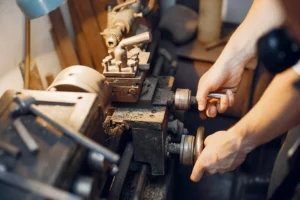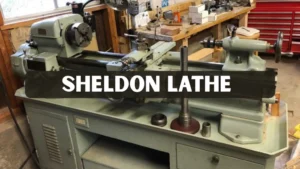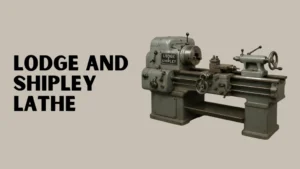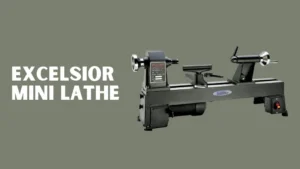Lathes often considered powerful tools for shaping various materials, can be surprisingly treacherous if not handled with the utmost care and attention. In this article, we will delve into the potential hazards associated with dangerous lathes, both wood, and metal, and provide essential safety precautions to mitigate the risks involved.
How Dangerous Is a Wood Lathe?

A wood lathe, while indispensable for crafting exquisite wooden pieces, can indeed become a perilous machine in the blink of an eye. Recognizing the perils of working with such dangerous lathes is paramount for woodworkers of all levels.
The Inherent Danger of High-Speed Rotation
One cannot underestimate the inherent danger of high-speed rotation in wood lathes. These dangerous lathes, when spinning at breakneck speeds, can turn wood into a formidable projectile, posing serious risks. Neglecting to remove the chuck key or encountering a machinery malfunction can cause the wood to launch dangerously in multiple directions. The ill-positioned chisel further amplifies the dangers lurking.
Wood Dust and Electric Malfunctions
Beyond the mechanical risks, wood lathes churn out fine wood dust particles that not only threaten your respiratory health but also elevate the likelihood of allergic reactions. Electric malfunctions and wiring issues loom as significant hazards in the operation of these dangerous lathes. Improper tool handling or loose clothing can lead to serious injuries. Regular maintenance and the use of safety gear are crucial for preventing accidents.
Safety Precautions When Using a Wood Lathe

To ensure your safety when operating such perilous wood lathes, here are crucial precautions to rigorously adhere to:
Clothing and Protective Equipment
- Remove Loose Items: Prioritize the removal of accessories like watches, rings, and necklaces, and ensure hair is securely tied up to avert potential entanglement. Loose clothing should also be avoided, as it can easily get caught in moving parts.
- Opt for Short Sleeves: Choose short sleeves over long ones to reduce the risk of garments becoming ensnared in the dangerous lathe’s whirl.
- Face Shield: Always wear a face shield to shield yourself from potentially hazardous wood shards; mere safety goggles are insufficient.
- Dust Mask: Guard against inhaling harmful wood dust by religiously wearing a dust mask during wood lathe operations.
RPM Control: Taming the Beast
- Set the Right RPM: Exercise meticulous control over Rotations Per Minute (RPM) on the lathe machine, tailoring it to the dimensions of your wooden work piece.
- Consult Speed Charts: Refer to speed charts to align your RPM with the appropriate workpiece size and specifications.
- Gradual Speed Adjustments: When dealing with larger pieces, remember to incrementally increase the lathe’s speed, preventing perilous accidents stemming from sudden surges.
Sharp Tools: The Shield Against Danger
- Maintain Sharpness: Keep your cutting tools in a razor-sharp state. Sharp tools not only boost safety but also enhance ease of operation.
Tool Rest Vigilance: Averting Danger
- Check the Tool Rest: Before lathe activation, ensure the tool rest is correctly positioned. Verify that the wood piece doesn’t make contact with the tool rest during operation.
Hearing Protection: Guarding Against Noise Danger
- Consider Hearing Protection: While not as critical as other safety measures, noise cancelling earphones can shield your ears when operating dangerous lathes for extended durations.
Vigilance Against Fatigue: A Safety Lifeline
- Avoid Working When Tired: Never underestimate the perils of fatigue. Dangerous lathes demand unwavering attention; avoid operating them when tired. Opt for shorter, frequent work sessions over prolonged, exhausting ones.
How Dangerous Is a Metal Lathe?
Metal lathes, designed for precision metalworking, introduce a distinct set of hazards. Understanding these dangers is pivotal for individuals working with these potentially perilous lathes.
Navigating the Landscape of Potential Hazards
- Heavy lifting of hefty metal workpieces.
- Exposure to the risk of contact, impact, or entanglement due to moving parts and loose objects.
- The presence of metal chips or swarf adds an element of danger.
- Liquid coolant, while essential, can be hazardous upon contact.
- Leaking hydraulic hoses pose severe risks.
- Inappropriate tooling and polishing techniques can lead to accidents.
- Noise levels can be harmful.
- The potential for slips, trips, and falls cannot be underestimated.
- Unexpected movements during maintenance, cleaning, or repairs can result in perilous situations.
Safety Precautions When Using a Metal Lathe
To effectively mitigate the dangers posed by metal lathes, meticulous adherence to these safety precautions is indispensable:
Enclosed Guards: Guarding Against Danger
- Enclose Parts in Interlocked Guards: Securely enclose parts, including chuck keys, tools, or swarf, within interlocked guards to prevent accidental impacts and entanglements.
Chuck Selection: Critical for Safety
- Use the Appropriate Chuck: Ensure you use the correct chuck tailored to the specific workpiece, averting any safety mishaps.
Maintaining a Clutter-Free Environment
- Keep Headstock Free of Loose Items: Maintain an environment devoid of clutter around the lathe’s headstock to sidestep potential entanglement hazards.
Dress Code: Guarding Against Entanglement Danger
- Avoid Loose Clothing and Accessories: Eschew loose clothing, jewellery, or gloves that could heighten the risk of entanglement.
Control Placement: Outsmarting Danger
- Properly Position Lathe Controls: Organize lathe controls to obviate the need for reaching through the work zone while the machine is in operation.
Workpiece Length: Ensuring Safety
- Avoid Extending Workpieces Beyond the Headstock: Workpieces should never extend beyond the lathe’s headstock. When required, provide ample support to prevent potential danger.
Conclusion
In the world of craftsmanship and metalworking, dangerous lathes are formidable allies, but they require the utmost respect and precaution. By comprehending the lurking dangers and faithfully adhering to the recommended safety protocols, you can ensure a secure and productive experience when working with these potentially perilous machines.
FAQ’s
Are lathes safe for beginners?
Lathes can be safe for beginners if they receive proper training and adhere to safety guidelines. Novices should start with supervision and gradually gain experience.
What should I do if I encounter a malfunction while using a lathe?
If you encounter any malfunction or unusual behavior with the lathe, immediately turn it off and consult a qualified technician for repairs.
Is personal protective equipment (PPE) essential when using lathes?
Yes, PPE such as face shields, dust masks, and hearing protection are crucial when operating lathes to safeguard against potential hazards.




